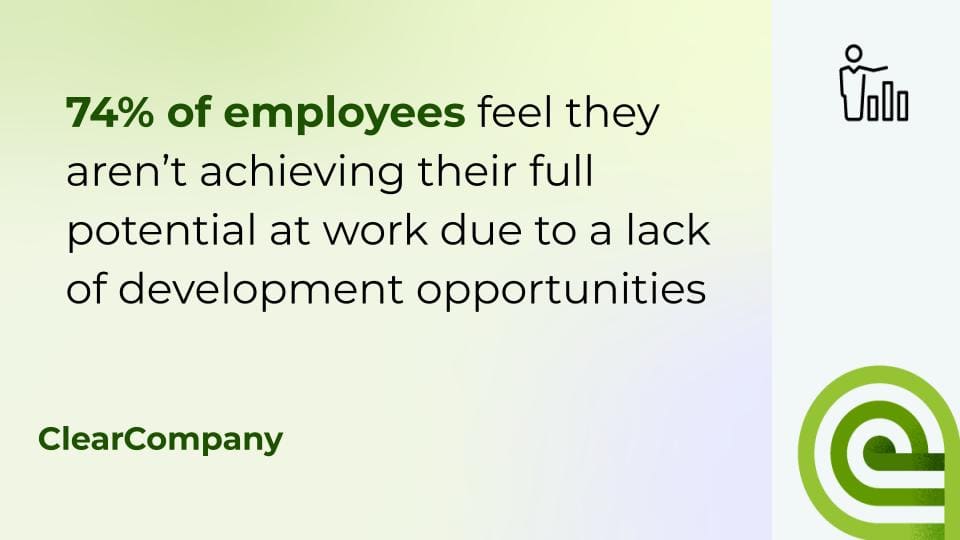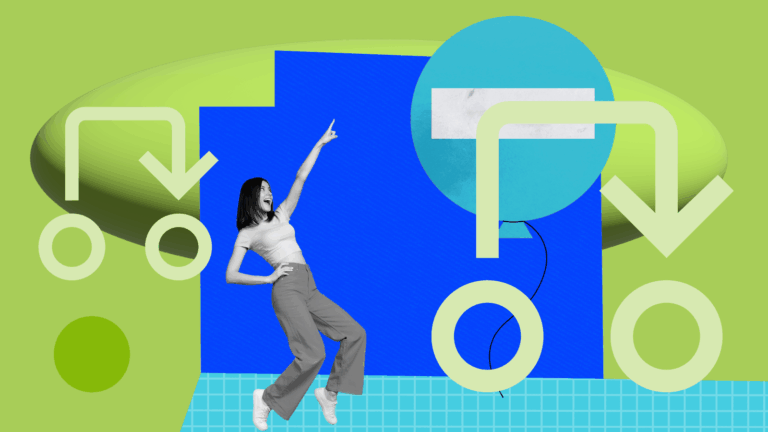
Wie man einen Mitarbeiterentwicklungsplan erstellt [Mit Beispielen aus der Praxis]

Investing in a structured Personalentwicklungsplan can unlock your team’s full potential and propel your organization to new heights. This comprehensive guide will equip you with a step-by-step framework and real-life employee development plan examples to cultivate a culture of continuous learning to propel your business forward.
Introduction to employee development plans
An employee development plan is a structured program that outlines the steps for an employee to enhance their skills, knowledge, and overall performance. It is a collaborative effort between the employee and their manager, focusing on aligning individual aspirations with organizational goals.
Companies can foster a more engaged and productive workforce by providing employees with opportunities to grow. Development plans can encompass various learning methods, including on-the-job training, mentoring programs, online courses, workshops, and formal education.
The benefits of implementing employee development plans
A culture of continuous learning and development is not just beneficial – it’s essential for survival. Implementing robust employee development plans is a strategic imperative for organizations aiming to thrive in the face of constant change and fierce competition. Let’s explore the multifaceted benefits that underscore the importance of prioritizing employee growth.
A well-structured employee development plan acts as a powerful retention tool. When employees perceive a genuine investment in their career trajectories, their loyalty strengthens significantly.
In fact, research indicates that retention is 34% higher among employees who have opportunities for berufliche Entwicklung.
By nurturing talent from within, organizations can cultivate a highly engaged workforce that’s less likely to seek opportunities elsewhere. This directly translates to reduced recruitment and onboarding costs, ensuring the retention of valuable institutional knowledge.
Furthermore, development plans empower employees to acquire new skills and enhance existing ones. This continuous upskilling not only elevates individual performance but also feeds directly into organizational growth. As employees become more adept in their roles and expand their skill sets, they contribute to increased productivity, efficiency, and innovation across the board. This internal capacity building enables companies to navigate industry shifts confidently, adopt emerging technologies, and maintain a competitive edge.
Investing in Mitarbeiterentwicklung also fosters a culture of learning and ambition. When employees see a clear path for advancement and skill development, they are more likely to be engaged and motivated. This, in turn, creates a positive work environment where individuals feel valued, challenged, and empowered to reach their full potential. A compelling 94% of employees stated they would stay longer at a company that invests in their careers, highlighting the profound impact of development initiatives on loyalty and engagement.
By addressing skill gaps and nurturing future leaders, organizations can proactively prepare for future workforce needs. Succession planning, facilitated by robust development programs, ensures a pipeline of qualified individuals ready to step into leadership roles. This strategic foresight minimizes disruption during transitions and ensures continuity in leadership, maintaining organizational stability and long-term success.
Comprehensive guide to creating an employee development plan
A well-structured employee development plan serves as a roadmap for both the employee and the organization to achieve shared goals. Here’s a step-by-step guide to crafting an effective plan:
Identifying business and individual goals
The first step in creating a development plan example is aligning individual aspirations with organizational objectives. Begin by identifying key business goals. Determine the skills, knowledge, and competencies required to achieve these goals. Simultaneously, encourage employees to reflect on their career aspirations, strengths, and areas they wish to develop. This collaborative approach ensures that individual growth contributes to overall business success.
Conducting a skills gap analysis
A skills gap analysis helps pinpoint the discrepancies between the current skill set of your workforce and the competencies needed to meet future demands. This analysis should encompass both hard and soziale Kompetenz. For instance, if your business aims to implement a new software system, evaluate whether your team possesses the necessary technical expertise. Similarly, assess if your team has the communication and collaboration skills needed to work effectively on cross-functional projects.
Setting clear, achievable objectives
Once you’ve identified the skills gaps, establish clear, measurable, achievable, relevant, and time-bound (SMART) objectives for employee development. For example, instead of a vague objective like “improve communication skills,” a SMART objective could be “attend a public speaking workshop within the next quarter and deliver a presentation to the team by the end of the fiscal year.” This level of specificity provides employees with a tangible target to strive for.
Designing action plans tailored to individual needs
Each employee’s development plan should be unique, catering to their specific roles, career goals, and identified skill gaps. This is where having diverse development plan examples for employees can be very beneficial. A combination of on-the-job training, mentoring programs, online courses, workshops, and conferences can be incorporated.
For someone looking to enhance leadership skills, enrolling in a leadership development program could be beneficial. Whereas, for an employee aiming to specialize in a particular technical area, pursuing a relevant certification would be more appropriate.
Involving managers and mentors for support
Managers and mentors play a crucial role in supporting employee development. They can provide guidance, resources, and opportunities for employees to practice new skills. Regular check-ins and coaching sessions can help employees stay on track with their development planning example and make necessary adjustments along the way. This collaborative approach fosters a culture of continuous learning and development within the organization.
Monitoring progress and providing feedback
Employee development is an ongoing process, not a one-time event. Regular monitoring of progress and providing constructive feedback are essential for its success. Utilize performance reviews, one-on-one meetings, and 360-degree feedback to track progress and identify areas for improvement.
Recognizing and celebrating achievements along the way can boost employee morale and motivation. Remember, feedback should be specific, timely, and actionable, empowering employees to continue growing and developing their skills.
Types of employee development plans with examples
Navigating the landscape of employee development requires a tailored approach, recognizing that one size does not fit all. Let’s explore some prominent types of employee development plan examples, each addressing specific needs and objectives:
Goal-based development plans
As the name suggests, goal-based development plans center around achieving specific, measurable, achievable, relevant, and time-bound (SMART) goals. These goals are often tied to an employee’s role, department objectives, or overall company strategic goals.
Example: A marketing assistant aiming to step into a content writing role might have a goal-based development plan focusing on enhancing their writing skills. Their plan could include completing online content writing courses, attending industry workshops, and shadowing senior content creators.
Skill-based development plans
Skill-based development plans prioritize bridging the gap between an employee’s current skills and the competencies needed for future roles or enhanced performance. These plans often leverage training programs, workshops, or online courses.
Example: A customer service representative struggling to effectively handle challenging customer interactions could benefit from a skill-based development plan. This plan might incorporate training on conflict resolution, active listening skills, and empathy building.
Leadership and succession planning
Investing in leadership and succession planning is crucial for the long-term health and sustainability of any organization. These development plans focus on identifying and nurturing high-potential employees, preparing them to assume leadership roles within the company.
Example: High-impact leadership organizations spend up to three times more on management development than their peers.
Leadership training has been shown to increase participants’ capacity for learning by 25% and their performance by 20%. A company might create a leadership development plan for a high-performing individual contributor, enrolling them in leadership training, assigning them mentorship opportunities with senior leaders, and providing them with opportunities to lead projects and teams.
Career pathing and role transition plans
Beruflicher Werdegang and role transition plans support employees in navigating their career journeys within the organization. These plans provide a clear roadmap outlining potential career progressions and the skills, experiences, and development opportunities needed to achieve their career aspirations.
Example: An employee expressing a desire to move from sales to marketing could work with their manager to create a career pathing plan. This plan would identify the necessary skills and experience for a marketing role and outline the steps the employee can take, such as cross-functional projects or relevant training, to make a successful transition.
Innovative examples from industry leaders
Leading companies continuously seek innovative approaches to Mitarbeiterentwicklung. These examples showcase the power of creative and forward-thinking development initiatives:
- Mentorship programs with a twist: Some companies are moving beyond traditional mentorship models to create reverse mentoring programs, pairing junior employees with senior leaders to foster knowledge sharing and diverse perspectives.
- Gamified learning platforms: Introducing elements of gamification, such as points, badges, and leaderboards, into online learning platforms can increase employee engagement and motivation.
- Personalized learning journeys: Leveraging technology and data analytics, companies can now curate personalized learning journeys for employees, recommending relevant courses, articles, and resources based on their skills, interests, and career goals.
Key components of an effective development plan
A well-structured employee development plan is crucial for its success. Here’s a breakdown of key components:
- Clear objectives: Begin by defining specific, measurable, achievable, relevant, and time-bound (SMART) objectives. These objectives should align with both the employee’s career aspirations and the organization’s strategic goals. For instance, if an employee aims to become a team leader, their development plan might include objectives related to improving communication, delegation, and conflict-resolution skills.
- Personalized learning paths: Each employee has unique strengths and areas for improvement. Tailor development plans to address these individual needs. This personalization might involve a combination of on-the-job training, mentoring, online courses, workshops, or conferences. For example, a software developer looking to enhance their coding abilities could benefit from a learning path that includes online coding courses and participation in hackathons.
- Timeline and milestones: Establish a clear timeline for achieving each objective, breaking down large goals into smaller, manageable milestones. This approach provides employees with a roadmap for their development journey and allows for regular progress checks. Suppose an employee aims to become proficient in data analysis. The timeline could include milestones such as completing a data analysis course within three months, applying those skills to a work project within six months, and independently leading a data analysis project within a year.
- Regular feedback and evaluation: Continuous feedback is essential to keep employees motivated and on track. Incorporate regular check-ins with managers or mentors to discuss progress, provide constructive criticism, and make any necessary adjustments to the plan. Performance reviews can also serve as opportunities to formally evaluate progress and set new goals. Using DevSkiller TalentBoost’s manager assessment feature, managers can gain detailed insights into their team’s skills, making these conversations much more data-driven and objective.
- Flexibility and adaptability: Recognize that individual circumstances and career goals can evolve over time. Build flexibility into the development plan to accommodate these changes. Be open to revisiting and revising objectives and learning paths as needed to ensure the plan remains relevant and engaging for the employee. For instance, if an employee discovers a passion for a different area within the company, the development plan should be adaptable enough to explore new opportunities and adjust career goals accordingly.
Employee development plan examples
Don’t reinvent the wheel when you can learn from the best! Streamlining your HR processes becomes significantly easier with well-structured templates. To help you get started with creating your own employee development plans, I have provided two development plan examples.
Template 1: Simple employee development plan examples
This first template offers a simple, straightforward approach, ideal for organizations just beginning to implement formal development plans.
Employee Name: [Employee Name]
Job Title: [Job Title]
Department: [Department]
Date: [Date]
Development Goal: [Clearly state the specific skill, knowledge, or competency the employee aims to develop].
Example: Improve presentation skills to deliver engaging and informative presentations to clients.
Action Steps: [List 3-5 concrete actions the employee will take to achieve the development goal].
Example:
1. Attend a workshop on effective presentation techniques.
2. Practice delivering presentations to colleagues and gather feedback.
3. Shadow a senior team member during client presentations.
Resources: [Identify resources available to support the employee, such as training programs, mentorship, online courses, or budget for external workshops].
Example:
- Company-sponsored training on presentation skills.
- Mentorship from the Marketing Manager.
- Access to online resources like Coursera for public speaking courses.
Timeline: [Establish a clear timeframe for achieving the development goal, including deadlines for each action step].
Example:
- Complete presentation skills workshop within the next quarter.
- Practice and deliver a presentation to colleagues within two months.
- Shadow the Marketing Manager during client presentations for the next two quarters.
Measurement: [Define how the employee’s progress and the success of the development plan will be evaluated].
Example:
- Improvement in presentation skills assessed through feedback from colleagues and the Marketing Manager.
- Successful delivery of a client presentation (evaluated based on client satisfaction and project outcomes).
Template 2: Comprehensive development plan example
This comprehensive sample of employee development plans provides a more detailed framework, suitable for organizations seeking a robust system to foster employee growth.
Employee Information
- Employee Name:
- Job Title:
- Department:
- Date:
Development Goals
- Goal 1: [Clearly state the development goal].
- Description: [Provide a concise explanation of the goal].
- Metrics for success: [Define how progress and achievement will be measured].
- Action plan: [Outline specific steps, timelines, and resources].
- Goal 2: [Repeat for each development goal].
Competency Development
- Core competencies: [List the core competencies required for the employee’s current role and their current proficiency level].
- Target competencies: [Identify areas for improvement and set target proficiency levels].
- Development activities: [List specific activities to bridge the competency gap, including training courses, on-the-job experiences, mentoring, etc.].
Career aspirations
- Short-term goals: [State the employee’s short-term career goals (e.g., within 1-2 years)].
- Long-term goals: [State the employee’s long-term career goals (e.g., beyond 2 years)].
- Potential career paths: [Explore potential career paths within the organization aligned with the employee’s aspirations].
Support and resources
- Manager/supervisor support: [Outline how the manager will support the employee’s development].
- Mentorship opportunities: [Identify potential mentors within the organization].
- Training and development Budget: [Specify the allocated budget for the employee’s development activities].
Review and evaluation
- Review schedule: [Establish regular check-in points to review progress, provide feedback, and make adjustments to the plan].
- Performance evaluation: [Link the development plan to the employee’s performance evaluation process].
By providing your employees with development plan examples like these, you provide a clear roadmap for success, paving the way for both individual and organizational growth.
Employee Development Platforms: Enhancing the Learning Experience
In today’s rapidly evolving business landscape, embracing technology isn’t just an option—it’s an imperative.
This rings especially true for Mitarbeiterentwicklung. As companies strive to foster a culture of continuous learning and upskilling, integrating a dedicated employee development platform can be transformative. But what exactly do these platforms offer, and how do they elevate the learning experience?
An employee development platform like DevSkiller provides a centralized hub for all development activities. Forget about disjointed spreadsheets and manual tracking. These platforms streamline the entire process, from identifying skill gaps and recommending relevant training to monitoring progress and measuring the impact of learning initiatives.
Let’s consider the impact of such a platform. Imagine accessing a comprehensive library of learning resources tailored to specific roles and skills, all within a single platform. DevSkiller, for example, leverages state-of-the-art skills ontologies to map over 4000 digital and IT skills. This empowers employees to acquire new knowledge and skills at their own pace, facilitated by personalized learning paths and engaging content formats.
Maintaining momentum: Following up on development plans
Creating a stellar Personalentwicklungsplan is a significant first step. However, the real magic happens when you prioritize consistent follow-up and evaluation. Without these elements, even the most meticulously crafted plans can lose their impact. Think of it like embarking on a road trip with a GPS but never bothering to check the directions – you might eventually reach your destination, but it will likely be a longer, less efficient journey.
Regular check-ins are crucial to ensure employees are on track to meet their objectives. These can be informal one-on-one meetings, quick progress reports, or even leveraging technology for digital check-ins. The frequency can vary depending on the plan’s complexity and the individual’s learning pace. Remember, the goal is to provide support, address roadblocks, and celebrate milestones, not to micromanage.

Feedback is another critical component of successful follow-up. It’s not enough to simply ask, “How’s it going?” Instead, encourage open and honest conversations about what’s working well and where adjustments might be needed. Remember, feedback is a two-way street. Encourage employees to share their insights and perspectives, fostering a collaborative approach to development.
By embedding a culture of continuous learning and development into the fabric of your organization, you’re not just investing in your employees’ futures – you’re investing in the future of your business.
Frequently asked questions about employee development plans
Navigating the terrain of employee development plans often brings up a few common questions. Let’s address these head-ons, providing clarity and practical insights.
What is the ideal duration for an employee development plan?
There’s no one-size-fits-all answer, as the timeframe should align with the specific goals, individual learning pace, and organizational context. However, a good starting point is to consider a plan spanning 6 to 12 months. This duration offers a balance between short-term achievements and long-term growth. For instance, a plan focused on acquiring a specific technical skill might have a shorter timeframe, while one geared towards leadership development could extend over a year or more.
How frequently should employee development plans be reviewed and updated?
Regular check-ins are crucial to keep the development journey on track. A best practice is to schedule quarterly reviews as a starting point. These sessions provide a structured opportunity to discuss progress, address challenges, and make adjustments based on evolving needs or priorities.
How can I measure the effectiveness of our employee development program?
Measuring the impact of your development initiatives is essential to demonstrate their value. Consider employing a blend of qualitative and quantitative metrics. Track factors such as:
- Employee engagement and retention rates: Are employees more engaged and likely to stay with the organization after participating in development programs?
- Performance improvement: Have you observed tangible improvements in individual or team performance metrics after implementing development plans?
- Goal attainment: What percentage of employees successfully achieved the objectives outlined in their development plans?
- Feedback and surveys: Gather feedback from both employees and their managers to assess the perceived value and impact of the development initiatives.
By analyzing this data, you gain insights into the effectiveness of your program and identify areas for continuous improvement.
Concluding remarks: The future of employee development
Employee development plans are no longer optional but essential for navigating this dynamic environment. Organizations that prioritize investing in their employees’ growth will be best positioned to adapt and thrive in the future.
This forward-thinking approach requires embracing innovative learning methods, leveraging technology, and fostering a culture of continuous feedback and improvement. By empowering employees to reach their full potential, businesses pave the way for both individual and organizational success. The future of work belongs to those who prioritize continuous learning and development.
Get in touch with DevSkiller and learn more about how to develop and manage development plans or watch our 5-min demo.




